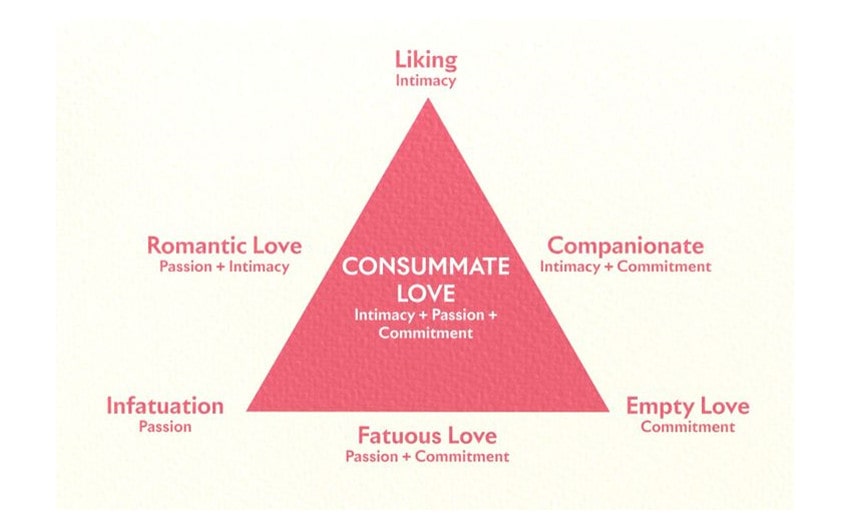Triangle of Love Theory: 7 Types of Romantic Connection
Love takes many forms, and understanding its complexities can help us build deeper, more fulfilling relationships. One way to explore this is through the triangle of love, a psychological theory developed by Dr. Robert Sternberg. This model breaks love down into three core components—intimacy, passion, and commitment—each playing a unique role in shaping the connections we share with others.
By examining how these elements combine, the triangle of love reveals different types of relationships and helps us better understand our own experiences with love. Let’s dive into the fascinating dynamics that form the foundation of our closest bonds.
Overview of Sternberg’s Triangle of Love Theory

Image source: Pinterest
Dr. Robert Sternberg, a renowned psychologist, developed the Triangle of Love theory in the 1980s as a way to better understand the dynamics of romantic and interpersonal relationships. According to Sternberg, love isn’t a single, uniform feeling but rather a combination of three essential components that interact to form different types of relationships. These components—intimacy, passion, and commitment—each play a unique role in shaping our connections with others. By examining how these elements are present or absent, we can identify various types of love and gain insight into our own relationships.
The Three Core Components
Intimacy: This is the emotional aspect of love and refers to the feelings of closeness, bonding, and connection that people experience with one another. Intimacy is built on trust, open communication, and mutual understanding. It grows over time as partners share experiences, support each other, and create memories together. Intimacy forms the “heart” of a relationship, giving it warmth and depth.
Passion: Passion is the physical and emotional excitement within a relationship. Often characterized by attraction, arousal, and the desire for physical closeness, passion can create a sense of thrill and energy, particularly in the early stages of a relationship. Although passion may start strong, it can fluctuate over time. It’s often associated with infatuation but can evolve into a deeper connection when paired with intimacy and commitment.
Commitment: Commitment is the decision to maintain a relationship over the long term. This component reflects a person’s dedication to staying with their partner and working through challenges together. Commitment brings stability to a relationship, allowing it to endure changes and difficult periods. It’s often the factor that keeps a relationship intact, especially when passion or intimacy temporarily fades.
How the Triangle Works Together
Sternberg’s theory suggests that the balance and presence of intimacy, passion, and commitment determine the nature and strength of a relationship. For example, a relationship with high intimacy and commitment but low passion may be deeply fulfilling as a friendship or companionate love.
Conversely, a relationship with passion but little intimacy or commitment may be intense but short-lived. In an ideal situation, all three components work together to create what Sternberg calls consummate love, often seen as the most complete and enduring form of love. However, the balance of these components may shift over time, adapting to life stages and personal growth within the relationship.
The Flexibility of Love Components
One of the fascinating aspects of Sternberg’s theory is that it recognizes love as dynamic rather than fixed. Intimacy, passion, and commitment aren’t necessarily constant; they may rise or fall depending on life circumstances, external pressures, or personal growth.
For instance, long-term relationships often experience fluctuations in passion, but intimacy and commitment can sustain the relationship through these periods. Understanding this flexibility can help partners navigate changes without feeling discouraged, as it’s normal for relationships to evolve over time.
Types of Love According to the Triangle Theory
According to Dr. Robert Sternberg’s Triangle of Love theory, the combination (or lack) of intimacy, passion, and commitment forms different types of love. These types represent the variety of relationships people experience throughout their lives, from casual connections to deep, lifelong bonds. By understanding the unique characteristics of each type, individuals can gain insight into their own relationships and better understand the dynamics that define them.
1. Liking (Intimacy Only)

“Liking” represents a deep sense of closeness and emotional connection with another person without the presence of passion or commitment. This type of love is often seen in close friendships, where trust, understanding, and open communication are strong, but there isn’t a romantic or physical attraction, nor a lifelong commitment.
Liking relationships can be very fulfilling and form the basis of companionship, as they offer emotional support and comfort. They are typically stable and enduring, built on shared interests, empathy, and mutual respect.
2. Infatuation (Passion Only)
Infatuation is characterized by strong physical attraction and excitement but lacks intimacy and commitment. It often manifests as a “crush” or initial attraction that creates intense feelings without a deep, emotional connection. Infatuation can be exhilarating, as it’s marked by passion, but it is typically short-lived, often fading when familiarity or reality sets in.
This type of love is often seen in the early stages of romantic relationships, where physical chemistry is high, but emotional bonds haven’t yet formed. While infatuation can be a stepping stone toward deeper love, it usually lacks the foundation needed for long-term stability.
3. Empty Love (Commitment Only)

Empty love exists when there is commitment in a relationship but without the emotional closeness (intimacy) or physical attraction (passion). This type of love is often seen in long-term relationships or marriages that have lost their spark or emotional connection over time.
Empty love can occur due to external factors, such as societal or family expectations, that keep two people together despite a lack of deep connection. While this type of love may feel stable due to commitment, it often requires effort and willingness to reignite intimacy or passion to become fulfilling again.
4. Romantic Love (Intimacy + Passion)
Romantic love is marked by both intimacy and passion but lacks the long-term commitment aspect. This type of love is often seen in relationships where there’s a strong emotional connection and physical attraction, but the partners aren’t yet committed for the long haul.
Romantic love is commonly experienced in early relationship stages, where two people are getting to know each other deeply while sharing an intense attraction. Although romantic love can feel all-encompassing, it may not be sustainable without the development of commitment. Many relationships start as romantic love and can evolve into a deeper connection as commitment grows.
5. Companionate Love (Intimacy + Commitment)

Companionate love combines intimacy and commitment but lacks passion. This type of love is often found in close friendships, familial bonds, or long-term partnerships where passion may have faded but emotional closeness and loyalty remain strong.
Companionate love is deeply rewarding, offering stability, trust, and a sense of partnership. It’s common in relationships where partners have been together for many years and have a profound emotional bond and commitment but may no longer experience intense romantic or physical attraction.
While companionate love may seem “quiet,” it provides the reliability and security that can make relationships fulfilling over the long term.
6. Fatuous Love (Passion + Commitment)
Fatuous love is built on passion and commitment but lacks the emotional closeness and depth of intimacy. This type of love can feel intense and may lead to quick commitments, such as whirlwind romances or impulsive marriages.
Fatuous love is often associated with relationships that are highly physical or romantic but haven’t developed a strong foundation of trust or emotional connection.
While fatuous love can feel exciting, it can also be risky, as the lack of intimacy may lead to misunderstandings or challenges as partners realize they don’t truly know each other on a deep level. For fatuous love to become enduring, it typically needs to develop intimacy over time.
7. Consummate Love (Intimacy + Passion + Commitment)

Consummate love is considered the ideal form of love in Sternberg’s theory, as it encompasses all three components: intimacy, passion, and commitment.
This balanced type of love is characterized by a deep emotional bond, strong physical attraction, and a dedicated commitment to maintaining the relationship over time. Consummate love is often seen as the “complete” form of love, offering both security and excitement, stability and thrill.
It requires effort, as each component needs nurturing to keep the relationship fulfilling. Couples in consummate love often feel a strong sense of partnership, understanding, and shared purpose, making it a resilient form of love that can adapt to life’s ups and downs.







